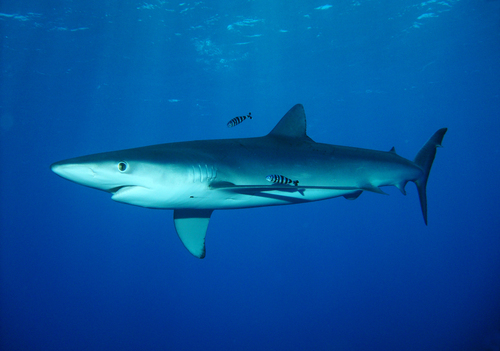
Blue Shark
The Atlantic bluefin tuna (Thunnus thynnus) is a highly migratory, large pelagic fish known for its remarkable size, speed, and commercial value. This species plays a crucial role in marine ecosystems and is a top predator. It's a fascinating fish.
15 20 years
Lifespan
383 cm
Length
Near Threatened
Conservation Status
69 km/h
Swimming speed
Carnivorous
Diet
Highly Migratory
Migration
Appearance Overview
The Atlantic bluefin tuna is renowned for its large, streamlined body, built for speed and endurance.
Color
Dark metallic blue above, silvery white below
Fins
Two dorsal fins, the first depressible; small finlets running from dorsal and anal fins to the tail
Body Shape
Torpedo-shaped, designed for efficient swimming
Length
Up to 13 feet (4 meters)
Weight
Up to 2,000 lbs (907 kg)
Diet
Carnivorous, feeding on a variety of fish, squid, crustaceans, and eels.
Feeding Behavior
Highly active predator, often hunting cooperatively, using speed and agility to capture prey. They can dive to significant depths.
Social Behavior
Forms large schools, especially during migration and spawning, but can also be found in smaller groups or solitary.
Commercial Relevance
Extremely high value, particularly in the sushi and sashimi markets, where its fatty flesh is considered a delicacy.
Conservation measures
Subject to international fishing quotas, stock management plans, and monitoring efforts. Some areas have implemented stricter regulations and fishing closures.
Status
Varies by population; some are considered Endangered or Critically Endangered, while others are Near Threatened.
Threats
Overfishing (historically the primary threat), bycatch in fishing gear, climate change affecting prey distribution and spawning grounds.
Habitat Distribution
Depth Range
0-1,000 meters (0-3,280 feet), though they are most commonly found in the upper layers of the ocean.
Geographic Range
Widely distributed in the Atlantic Ocean, from Newfoundland to the Gulf of Mexico, and from Norway to the Mediterranean Sea.
Preferred Environment
Primarily pelagic, inhabiting temperate and subtropical waters; also ventures into colder regions.
Reproduction and Life Cycle
Breeding Habits
Spawns in warm waters, with two main spawning grounds: the Mediterranean Sea and the Gulf of Mexico. Spawning typically occurs in spring and summer.
Development Stages
Eggs are pelagic and hatch into larvae that feed on plankton. Juveniles grow rapidly, reaching significant size within their first year.
Fecundity
Highly fecund; a single female can release up to 30 million eggs per spawning season.
Maturity Age
Reaches sexual maturity at around 4-8 years, depending on the population and environmental conditions.
Faqs about Blue Shark
How long do Atlantic bluefin tuna live?
They can live up to 40 years, though this is less common due to fishing pressure.
How fast can Atlantic bluefin tuna swim?
They are among the fastest fish in the ocean, capable of bursts of speed up to 40-60 mph.
Are Atlantic bluefin tuna warm-blooded?
Yes, they are warm-blooded, which allows them to maintain a higher body temperature than the surrounding water, aiding in muscle efficiency.
Do Atlantic bluefin tuna migrate?
They undertake extensive migrations across the Atlantic Ocean, often traveling thousands of miles between feeding and spawning grounds.
Why are Atlantic bluefin tuna endangered?
Overfishing has significantly depleted many populations, driving them to endangered status in some regions.
Copyright @ Nature Style Limited. All Rights Reserved.
 English
English